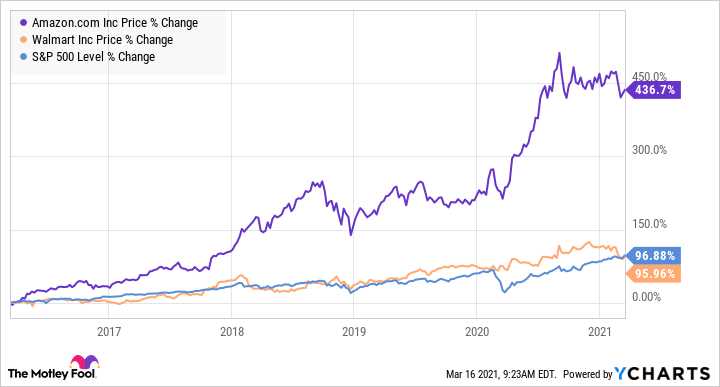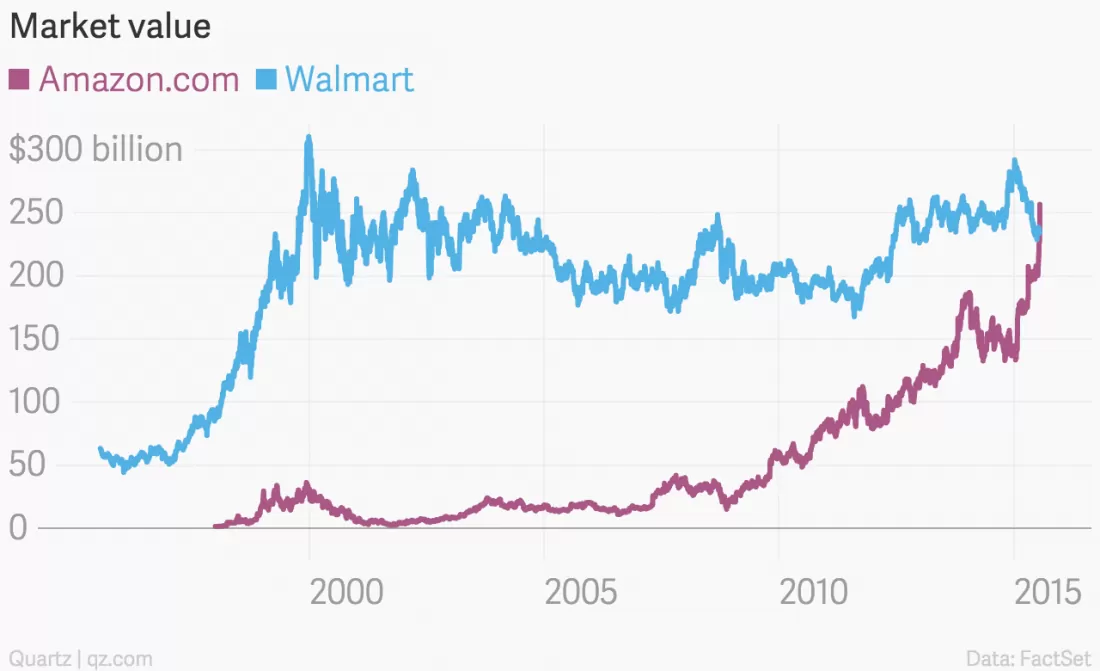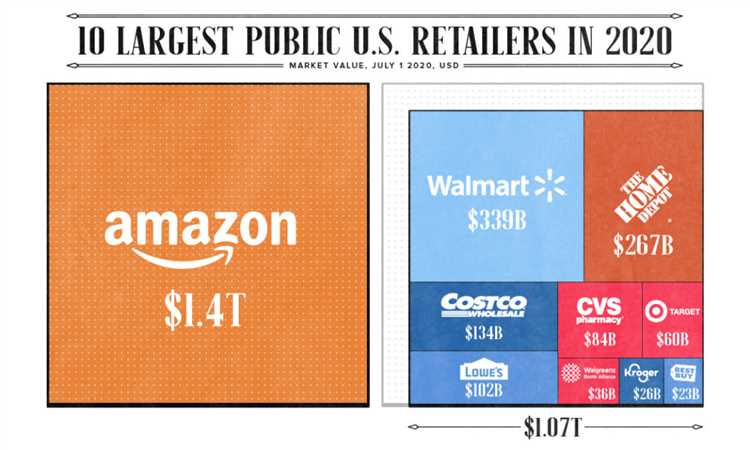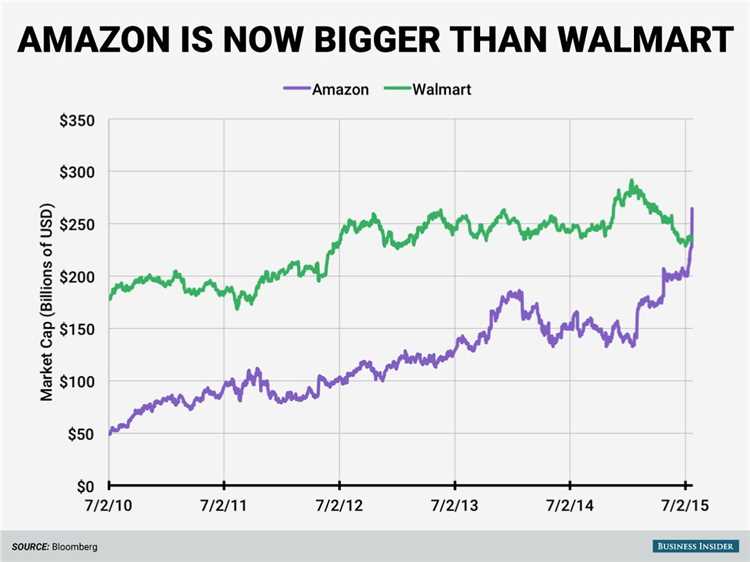
When it comes to online shopping, two names instantly come to mind: Amazon and Walmart. These two retail giants have dominated the e-commerce market for years, and continue to expand their reach and influence. Both companies have built their success on a foundation of convenience, competitive pricing, and a vast selection of products. However, with their different business models and strategies, they have created a distinct identity in the retail world.
Amazon, founded by Jeff Bezos in 1994, started as an online bookstore and quickly grew to become the largest online marketplace in the world. It revolutionized the way people shop, offering a wide range of products, fast delivery options, and innovative features such as Amazon Prime and one-click purchasing. With its customer-centric approach and relentless focus on innovation, Amazon has become synonymous with online shopping.
On the other hand, Walmart, founded by Sam Walton in 1962, is a brick-and-mortar retail giant that has successfully transitioned into the e-commerce space. With its extensive network of physical stores, Walmart has established itself as a one-stop shop for everyday needs. Recently, the company has ramped up its online presence by acquiring various e-commerce platforms and investing in technology to compete with Amazon head-on.
Despite their differences, both Amazon and Walmart are known for their aggressive pricing strategies. Amazon offers competitive prices, often undercutting traditional retailers, while Walmart is famous for its commitment to providing customers with the lowest prices. This price-centric approach has allowed both companies to attract customers and dominate the retail market.
In conclusion, when it comes to the battle for retail dominance, Amazon and Walmart are the undisputed leaders. While Amazon has revolutionized online shopping and set the bar high for customer experience, Walmart continues to evolve and adapt, leveraging its physical stores to compete with Amazon’s e-commerce empire. Ultimately, it is the consumers who benefit from the fierce competition between these two giants, as they both strive to offer the best products, prices, and shopping experience.
- Overview of Amazon and Walmart
- Market Share and Revenue
- Online Presence and E-commerce
- Physical Stores and Local Presence
- Customer Experience and Services
- Amazon
- Walmart
- Question-answer:
- Which company has more revenue, Amazon or Walmart?
- What is the market capitalization of Amazon and Walmart?
- What are the main differences between Amazon and Walmart?
- Which company has a larger online presence, Amazon or Walmart?
- What is the growth rate of Amazon and Walmart?
Overview of Amazon and Walmart

Amazon and Walmart are two of the biggest retail giants in the world, each with their own unique strengths and strategies. While Amazon is known for its dominance in online retail, Walmart has a strong presence in brick-and-mortar stores.
Founded in 1994, Amazon started as an online marketplace for books but quickly expanded its product offering. Today, it offers a wide range of products, including electronics, clothing, and household goods. Amazon has revolutionized the retail industry with its convenient shopping experience and efficient delivery services. Its Prime membership program has also been a major success, providing customers with additional perks such as free two-day shipping and access to streaming services.
On the other hand, Walmart has a long history in the retail industry, with its first store dating back to 1962. Known for its low prices and vast product selection, Walmart has become a household name in the United States and has expanded internationally. It operates both supercenters that offer groceries and general merchandise and smaller neighborhood markets. Additionally, Walmart has been investing in its e-commerce capabilities to compete with Amazon in the online space.
Both Amazon and Walmart have been increasingly focused on innovation and technology. Amazon has pioneered the use of artificial intelligence and machine learning algorithms to improve its product recommendations and streamline its operations. Walmart, on the other hand, has been exploring the use of drones for delivery and has been investing in digital initiatives to enhance the customer experience.
In terms of revenue, Amazon has been outpacing Walmart in recent years. However, Walmart still maintains a larger physical footprint with its thousands of stores worldwide. Both companies are constantly evolving and adapting to the changing retail landscape, as they compete to attract customers and expand their market share.
Market Share and Revenue
When it comes to market share and revenue, both Amazon and Walmart are major players in the retail industry. However, Amazon has been able to capture a larger market share and generate more revenue compared to Walmart in recent years.
Amazon’s Market Share and Revenue:
Amazon is known for its dominant presence in the e-commerce market. As of 2020, the company holds approximately 40% of the e-commerce market share in the United States. This strong market position has allowed Amazon to generate significant revenue.
In 2020, Amazon’s net sales reached a staggering $386 billion, a 38% increase compared to the previous year. This growth can be attributed to the company’s wide range of products, competitive pricing, and superior customer service.
Walmart’s Market Share and Revenue:
Walmart, on the other hand, is a well-established retailer with a strong presence in the brick-and-mortar space. While it has made efforts to expand into the e-commerce sector, its market share in online retail is still smaller compared to Amazon.
As of 2020, Walmart’s e-commerce market share stood at around 5%, significantly lower than that of Amazon. However, the company still holds a significant market share in the overall retail industry due to its extensive network of physical stores.
In terms of revenue, Walmart reported net sales of $559 billion in 2020, making it one of the largest retail companies globally. While its revenue is higher compared to Amazon, it is important to note that Walmart operates in various segments such as groceries, pharmaceuticals, and general merchandise, whereas Amazon primarily focuses on e-commerce.
In conclusion, while Walmart continues to be a retail giant with substantial revenue, Amazon’s dominance in the e-commerce market has allowed it to capture a larger market share and generate significant revenue. The competition between these two retail giants is fierce, and it will be interesting to see how their market shares and revenues evolve in the future.
Online Presence and E-commerce
Both Amazon and Walmart have a strong online presence and are major players in the e-commerce industry. However, when it comes to online retail, Amazon undoubtedly takes the lead. It has established itself as the go-to online shopping destination for millions of customers around the world.
Amazon’s success can be attributed to its wide product selection, competitive prices, and user-friendly interface. The company offers a vast range of products, from books and electronics to clothing and household items. It also provides various services like Amazon Prime, which offers free shipping and access to exclusive deals, further enhancing its appeal to customers.
Moreover, Amazon has invested heavily in its e-commerce infrastructure, ensuring a seamless shopping experience for its customers. Its sophisticated logistics network allows for quick and reliable delivery, often within two days or even the same day in some areas. Additionally, Amazon’s customer service is known for its responsiveness and efficiency, further building customer trust and loyalty.
While Walmart has been slower in adapting to the online marketplace, the retail giant has ramped up its e-commerce efforts in recent years to compete with Amazon. It has made significant investments in technology and acquisitions, aiming to expand its digital presence and improve its online shopping experience.
Walmart offers various online services, including the option to shop for groceries online and pick them up at a local store. This convenient service has gained popularity among customers looking for a hassle-free way to purchase everyday essentials. Walmart has also introduced Walmart+, a subscription service that provides benefits like free unlimited delivery and discounts on fuel.
Both Amazon and Walmart recognize the importance of e-commerce in today’s digital age and are continuously innovating and improving their online platforms to stay ahead of the competition.
- Amazon offers a more extensive selection of products and a user-friendly interface.
- Walmart provides convenient online grocery shopping and a subscription service.
Ultimately, the battle for dominance in the online retail space continues between Amazon and Walmart, with both retail giants constantly striving to provide the best e-commerce experience for their customers.
Physical Stores and Local Presence
When it comes to physical stores and local presence, Walmart has a clear advantage over Amazon. With over 11,000 stores worldwide, Walmart has a strong presence in local communities. These stores not only serve as retail locations but also act as distribution centers, allowing Walmart to offer same-day pickups and deliveries. This local presence ensures that customers can easily access Walmart’s products and services.
On the other hand, Amazon, known primarily for its online presence, has been making efforts to establish physical stores. The acquisition of Whole Foods Market in 2017 provided Amazon with over 500 physical locations. This move allowed Amazon to expand its reach into the grocery retail sector and experiment with concepts such as cashierless stores.
While Amazon has also introduced Amazon Go stores, which utilize advanced technology to provide a cashierless shopping experience, they are still limited in number. These stores, though popular, are only available in select cities, limiting Amazon’s physical presence compared to Walmart.
Walmart’s extensive network of physical stores gives the company an edge in terms of convenience and accessibility. Customers can visit a nearby Walmart store to physically examine products before making a purchase. This also provides an opportunity for customers to take advantage of additional services like product returns and exchanges.
However, it’s worth noting that Amazon’s local presence isn’t completely absent. The company has established Amazon Lockers in various locations where customers can pick up their online orders. These lockers are usually located in stores, airports, and other public places, making it more convenient for customers to collect their packages.
In conclusion, while Amazon has been expanding its physical presence, Walmart remains the leader when it comes to physical stores and local presence. Walmart’s extensive network of stores ensures that customers have easy access to its products and services, providing a level of convenience that Amazon is still working to match.
Customer Experience and Services
Both Amazon and Walmart prioritize providing exceptional customer experience and services to their shoppers. They understand the importance of creating a seamless online shopping journey and offering convenience and satisfaction to their customers.
Amazon

Amazon is well-known for its customer-centric approach. The e-commerce giant provides a user-friendly interface and personalized recommendations based on customer preferences, browsing history, and purchase behavior. This helps customers discover products that align with their interests and needs.
One of Amazon’s standout features is its Prime membership program. With Prime, customers get access to benefits like free and fast shipping, exclusive deals and discounts, and streaming services through Prime Video and Prime Music. These perks enhance the overall shopping experience and incentivize customers to choose Amazon over competitors.
Furthermore, Amazon has a highly efficient and responsive customer service team. They offer multiple channels for customer support, including live chat, phone, and email. Customers can easily reach out for assistance with their orders, returns, or any other inquiries they may have.
Walmart

Walmart is committed to improving its omnichannel capabilities to provide a seamless shopping experience for its customers. They have made significant investments in technology to enhance their e-commerce platform and integrate it with their physical stores.
One of Walmart’s customer-focused initiatives is its Online Grocery Pickup service. Customers can order groceries online and schedule a time to pick them up at their local Walmart store. This convenient service saves customers time and offers them the flexibility to choose the most convenient pickup location and time slot.
Walmart also offers a subscription-based service called Walmart+, which is similar to Amazon Prime. Walmart+ members enjoy benefits such as free shipping with no minimum order requirement, savings on fuel at Walmart and Murphy USA gas stations, and access to the Scan & Go feature in the Walmart app for fast and contactless shopping.
Walmart’s customer service team is easily accessible, with options for phone support and online chat. They are available to assist customers with any inquiries or issues that arise during their shopping experience.
In conclusion, both Amazon and Walmart prioritize customer experience and offer various services to enhance the overall shopping journey. While Amazon stands out with its personalized recommendations and Prime membership program, Walmart focuses on integrating its online and physical stores and providing convenient services like Online Grocery Pickup and Walmart+.
Question-answer:
Which company has more revenue, Amazon or Walmart?
As of 2021, Amazon has higher revenue than Walmart. In fact, Amazon is currently the largest retailer in the world in terms of revenue.
What is the market capitalization of Amazon and Walmart?
As of 2021, Amazon has a larger market capitalization than Walmart. Amazon’s market cap is around $1.7 trillion, while Walmart’s market cap is around $409 billion.
What are the main differences between Amazon and Walmart?
There are several main differences between Amazon and Walmart. Firstly, Amazon is primarily an e-commerce company, while Walmart is a traditional brick-and-mortar retailer. Secondly, Amazon offers a wide range of products from various sellers, while Walmart mainly sells its own inventory. Thirdly, Amazon has a strong focus on technological innovation, while Walmart is more focused on its physical stores.
Which company has a larger online presence, Amazon or Walmart?
Amazon has a larger online presence compared to Walmart. Amazon is well-known for its dominant position in the e-commerce market, while Walmart has been investing heavily in its online capabilities in recent years to catch up with Amazon.
What is the growth rate of Amazon and Walmart?
Both Amazon and Walmart have experienced significant growth in recent years, but Amazon has generally been growing at a faster rate. Amazon’s revenue growth rate has been above 30% in recent years, while Walmart’s growth rate has been around 2-3%.